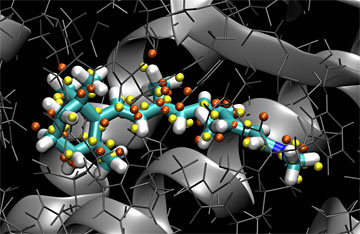Leonardo Guidoni
Leonardo Guidoni
Fri, Aug. 8, 2014, 3:00pm - 4:00pm
Frick Chemistry Laboratory, A81
Host: Annabella Selloni
Quantum Monte Carlo for Correlated (Bio)molecules and Ab Initio Molecular Dynamics
Quantum Monte Carlo (QMC) methods are recently emerging as competitive tool to tackle the electronic structure of molecules with strong electron correlation. Recent progresses in the field have shown that QMC calculations can offer an accurate description of the relaxed geometrical parameters and of the electronic structure of molecules up to 100 atoms with unprecedented accuracy. This is now possible thanks to three main reasons: the development of new algorithms, the favourable scaling of QMC with the number N of electrons (∼N3-N4) and the excellent scalability on High Performance Computing facilities (linear speedup up to hundreds of thousands of CPU cores) [1].
 In this seminar I will present an overview of recent advances in Variational Monte Carlo techniques using the Jastrow Antisymmetrised Geminal Power (JAGP) wavefunction based on Pauling’s resonating valence bond idea. The use of correlated but compact wave functions with optimization of all variational parameters allows us to precisely compute ground and excited state states geometries, vibrational properties, transition state structures, electronic densities, diradical and radical states, and polarizabilities of molecules where the electron correlation play an important role [2]. Combining VMC geometry optimization with Many Body Green’s Function Theory it is also possible the accurate evaluation of both the geometries and electronic excitations of biological chromophores in gas phase and in their protein environment (through a Quantum Monte Carlo/Molecular Mechanics scheme). Biophysical applications include the spectral tuning of the Retinal chromophores in Rhodopsin and the role of the bond length alternation in carotenoids [3]. A scheme of first principle finite temperature molecular dynamics based on Variational Monte Carlo has been recently introduced by Sorella and co-workers and successfully applied to high-pressure hydrogen [4]. We have also applied this method to a 32 box of water molecules, successfully obtaining the structural properties of liquid water at room temperature.
In this seminar I will present an overview of recent advances in Variational Monte Carlo techniques using the Jastrow Antisymmetrised Geminal Power (JAGP) wavefunction based on Pauling’s resonating valence bond idea. The use of correlated but compact wave functions with optimization of all variational parameters allows us to precisely compute ground and excited state states geometries, vibrational properties, transition state structures, electronic densities, diradical and radical states, and polarizabilities of molecules where the electron correlation play an important role [2]. Combining VMC geometry optimization with Many Body Green’s Function Theory it is also possible the accurate evaluation of both the geometries and electronic excitations of biological chromophores in gas phase and in their protein environment (through a Quantum Monte Carlo/Molecular Mechanics scheme). Biophysical applications include the spectral tuning of the Retinal chromophores in Rhodopsin and the role of the bond length alternation in carotenoids [3]. A scheme of first principle finite temperature molecular dynamics based on Variational Monte Carlo has been recently introduced by Sorella and co-workers and successfully applied to high-pressure hydrogen [4]. We have also applied this method to a 32 box of water molecules, successfully obtaining the structural properties of liquid water at room temperature.
[1] Sorella, S.; Capriotti, L., J. Chem. Phys. 2010, 133, 234111. Coccia, E. and Guidoni, L., J. Comput. Chem. 33, 2012, 2332.
[2] Barborini, M.; Sorella, S.; Guidoni, L., J. Chem. Theory Comput. 2012, 8, 1260. Barborini, M. and Guidoni, L. J. Chem. Phys. 2012, 137, 224309. Zen, A.; Coccia, E.; Luo, Y.; Sorella, S.; Guidoni, L. J. Chem. Theory Comput. 2014, 10, 1048. D. Varsano, M. Barborini, L. Guidoni, J. Chem. Phys., 2014, 140, 054102.
[3] Coccia E.; Varsano D. and Guidoni L., J. Chem. Theory Comput. 2013, 1, 8. Coccia, E.; Varsano, D. and Guidoni, L. J. Chem. Theory Comput., 2014, 10, 501.
[4] Mazzola, G.; Zen, A; Sorella, S. 2012 137 (13), 134112. Mazzola, G.; Yunoki S.; Sorella S. Nat. Comm. 2014, 5, 3487.
